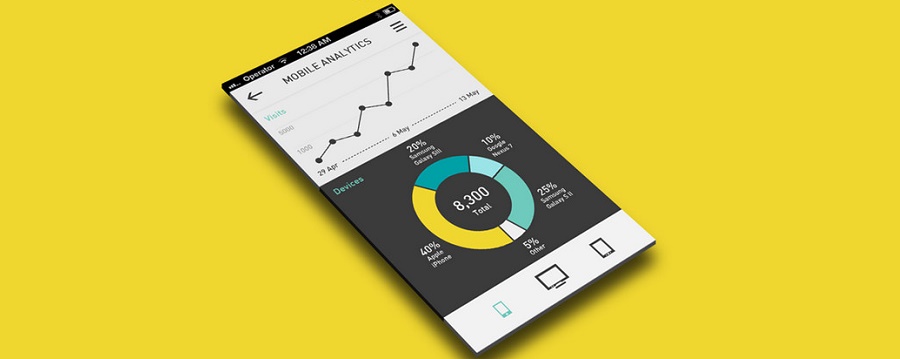10 Best Mobile App Analytics Tools For 2025 (Ranked & Reviewed)
Find the right mobile app analytics tools to monitor performance, increase engagement, and drive growth. Compare top options and key features in this guide.

Feb 20, 2025
The mobile app industry continues to evolve at a rapid pace, with millions of applications competing for user attention. Simply launching an app is not enough, sustained success requires a deep understanding of user behavior, app performance, and marketing effectiveness. This is where mobile app analytics tools come into play.
These tools help businesses track user engagement, retention, conversions, crashes, and overall app performance, enabling them to optimize their apps based on data-driven insights. With advancements in AI-driven analytics, real-time data processing, and privacy-focused tracking, 2025 offers an array of sophisticated analytics solutions for developers, product managers, and marketers.
This article will discuss the importance of mobile app analytics, key features to look for, top tools in 2025, and how to choose the best solution for your needs.
What Are Mobile App Analytics Tools?
Mobile app analytics tools are software solutions that help app developers, marketers, and businesses track and analyze user behavior, app performance, and key metrics. These tools collect data on how users interact with an app, from downloads and screen views to engagement, retention, and revenue generation.
By using mobile app analytics tools, businesses can gain valuable insights to improve user experience, optimize marketing campaigns, and enhance app functionality. The data gathered helps answer important questions like how users navigate through an app, where they drop off, what features they use most, and what factors contribute to retention or churn.
Modern mobile analytics tools also integrate with artificial intelligence and machine learning to provide predictive analytics, anomaly detection, and personalized recommendations. They play a crucial role in helping app owners make data-driven decisions to increase user engagement, improve app stability, and maximize revenue. As more companies adopt mobile apps for business, analytics tools become essential for tracking app success, understanding customer needs, and staying ahead of the competition.
Importance Of Mobile App Analytics Tools
Mobile app analytics tools are the key to unlocking valuable insights about your app's performance and user engagement. They transform raw data into actionable intelligence, empowering you to make informed decisions that drive growth.
1. Understanding User Behavior
Analytics tools reveal how users interact with your app. They track user flows, identify popular features, and pinpoint drop-off points, providing a clear picture of the user journey. This information is invaluable for optimizing the user experience and improving engagement.
2. Measuring App Performance
Beyond user behavior, analytics tools also monitor technical performance. They track crash rates, load times, resource usage, and other vital metrics, enabling you to identify and address performance bottlenecks that can negatively impact the user experience.
3. Optimizing User Acquisition
Attracting the right users is crucial for app success. Analytics tools help you understand which marketing channels are driving the most valuable users, allowing you to optimize your user acquisition campaigns and maximize your ROI.
4. Improving User Engagement And Retention
Keeping users engaged and coming back for more is essential for long-term growth. Analytics tools help you understand user behavior patterns and preferences, allowing you to personalize the user experience and reduce churn.
5. Driving Revenue Growth
For monetized apps, analytics tools are essential for tracking revenue generation. They provide insights into in-app purchases, ad revenue, subscription metrics, and other monetization data, enabling you to optimize your revenue strategies.
How Do Mobile App Analytics Tools Work?
1. Event Tracking And User Behavior Analysis
A good mobile app analytics tool helps track how users interact with different parts of the app. It allows you to see what features people use the most, which buttons they tap, and how they navigate through the app.
Some advanced tools also provide heatmaps and session recordings, which visually show where users spend time and where they experience difficulties. This data helps developers improve the app’s design and functionality.
2. Retention And Cohort Analysis
Understanding how many users return to your app over time is crucial for long-term success. Retention tracking shows how often users come back daily, weekly, or monthly. Cohort analysis goes deeper by grouping users based on their behaviors, allowing you to compare retention rates between different user groups.
This helps identify patterns and find ways to keep users engaged. Churn analysisis also useful in detecting why users stop using the app, so you can address those issues.
3. Funnel And Conversion Analysis
Analyzing the steps users take before completing an action like signing up, making a purchase, or subscribing is key to optimizing the app experience. Funnel analysis helps track user journeys and identify points where users drop off.
If many users abandon a process at the same stage, it signals a problem that needs fixing. A/B testing can also be used to compare different versions of a feature and determine which one works better for improving conversions.
4. Crash And Performance Monitoring
To keep your app running smoothly, it’s important to monitor crashes and performance issues. A good analytics tool provides real-time crash reports with detailed logs, helping developers quickly identify and fix problems.
It also tracks how fast the app loads and how well it performs across different devices and operating systems. Addressing these issues quickly leads to a better user experience and higher retention rates.
5. AI-Powered Predictive Analytics
Artificial intelligence is transforming mobile app analytics by providing predictive insights. Some tools can forecast which users are likely to stop using the app, allowing businesses to take action before they lose engagement.
AI also helps detect unusual user behavior, flagging potential issues in real time. Personalization features powered by AI can recommend content or features based on user preferences, improving engagement and satisfaction.
6. Privacy And Compliance Features
With strict data privacy laws like GDPR, CCPA, and Apple’s App Tracking Transparency (ATT) framework, a good analytics tool should prioritize user data protection.
It should offer features for managing user consent, anonymizing data, and ensuring compliance with global privacy regulations. Secure data storage and encryption also play a crucial role in protecting user information and maintaining trust.
7. Data Collection
Mobile analytics tools gather data from various sources, including user interactions, device sensors, and network activity. They track key events such as app installs, screen views, button clicks, and in-app purchases.
Some tools use software development kits (SDKs) that developers integrate into their apps to enable automatic data collection. By leveraging mobile data analytics, businesses can gain deeper insights into user behavior, optimize app performance, and refine marketing strategies to enhance engagement and retention.
8. Privacy And Compliance
With strict data privacy laws like GDPR and CCPA, analytics tools now include features for data protection. They offer anonymized tracking, user consent management, and compliance reports to ensure businesses handle user data responsibly.
Top Mobile App Analytics Tools In 2025
1. Google Analytics For Firebase
Google Analytics for Firebase remains a top choice for mobile app developers due to its deep integration with Android and iOS. It provides real-time event tracking, user segmentation, and crash reporting through Firebase Crashlytics.
The tool also offers predictive analytics powered by AI, allowing businesses to forecast user behavior and improve retention. With seamless integration with Google Ads, Firebase helps track app campaigns and measure their effectiveness.
2. Amplitude
Amplitude is known for its powerful behavioral analytics, allowing app owners to track user journeys, cohort retention, and funnel analysis in great detail. The tool uses machine learning to provide insights into why users engage, convert, or churn. Amplitude’s predictive analytics and customer segmentation features make it a strong choice for businesses looking to optimize user engagement.
3. Mixpanel
Mixpanel specializes in real-time analytics, helping app developers track user interactions and analyze trends quickly. It offers in-depth event tracking, funnel analysis, and A/B testing capabilities. One of Mixpanel’s standout features is its ability to provide automated insights, helping businesses understand how changes in their app impact user behavior.
4. Flurry Analytics
Flurry, owned by Yahoo, is a free analytics tool offering detailed insights into app performance and user behavior. It provides real-time metrics, audience segmentation, and retention tracking. Flurry is particularly popular among small and medium-sized app developers looking for a cost-effective solution with strong reporting capabilities.
5. Adjust
Adjust is a mobile measurement platform focused on app attribution and fraud prevention. It helps businesses track user acquisition sources, measure ad campaign effectiveness, and detect fraudulent activity. With features like deep linking, cohort analysis, and real-time tracking, Adjust is a top choice for marketers optimizing their app growth strategies.
6. Appsflyer
Appsflyer is another leading mobile attribution and analytics tool used by marketers and app developers. It provides in-depth campaign tracking, ROI measurement, and fraud detection. Appsflyer’s SKAdNetwork support makes it an excellent choice for apps that rely on Apple’s privacy-focused attribution model.
7. UXCam
UXCam is designed for user experience analytics, focusing on session recordings, heatmaps, and gesture tracking. It helps developers understand user frustrations by identifying where users struggle within the app. UXCam’s data-driven insights improve app usability and retention rates.
8. Smartlook
Smartlook combines qualitative and quantitative analytics, offering session replays and event-based tracking. It helps developers analyze user interactions and identify bottlenecks in the app experience. Smartlook is widely used for mobile apps that require detailed user journey analysis.
9. Countly
Countly is an open-source mobile analytics platform that prioritizes data privacy. It provides real-time analytics, push notification tracking, and offline data collection. Businesses that want full control over their analytics data while ensuring compliance with privacy regulations prefer Countly. For entrepreneurs looking to start an online business, Countly offers valuable insights into user behavior, helping them refine their app strategies and improve customer engagement.
10. Localytics
Localytics offers personalized app engagement solutions, including push notifications, in-app messaging, and retention tracking. It helps businesses drive user engagement through automated marketing campaigns based on behavior analytics. Localytics is especially useful for apps that focus on customer loyalty and retention.
How Choose The Right Mobile App Analytics Tools
Selecting the right analytics tools is crucial for maximizing their value.
1. Define Your Objectives
Before choosing any tools, clearly define your specific goals and the metrics you want to track. What are you trying to achieve with your app? What key performance indicators (KPIs) are most important to you?
2. Consider Your Budget
Mobile app analytics tools come with different pricing models, including free, freemium, and paid plans. Consider your budget and choose tools that offer the features you need at a price you can afford.
3. Evaluate Features And Functionality
Assess the features and functionalities offered by different tools and choose the ones that align with your specific needs. Do you need advanced segmentation capabilities? Is A/B testing integration important?
4. Integration With Other Tools
Consider how well the analytics tools integrate with your other development, marketing, and CRM tools. Seamless integration can streamline your workflow and improve data analysis.
5. Ease Of Use And Reporting
Choose tools with a user-friendly interface, clear reporting capabilities, and insightful data visualization features. The easier it is to use the tools and understand the data, the more likely you are to use them effectively.
FAQs
What Is Mobile Analytics Tools?
Mobile analytics focuses on unique users and captures their demographics, behaviors, and interactions within an app's user experience. It then groups that information with that of similar users to better track trends.
How To Analyze A Mobile App?
Analyze your app's user behavior: Look at how users interact with your app, such as which features they use the most, how long they spend on the app, and what actions they take. This can help you identify which metrics are most important to track.
What Is The Difference Between User Acquisition And User Retention?
User acquisition refers to the process of attracting new users to your app. User retention refers to the ability to keep existing users engaged and coming back to your app.
Final Thoughts
In 2025, mobile app analytics tools are more advanced than ever, providing AI-driven insights, real-time tracking, and enhanced privacy features. If you're a startup, enterprise, or indie developer, choosing the right tool can increase retention, optimize marketing, and boost revenue. Invest in analytics today and turn raw data into actionable insights for long-term app success.


